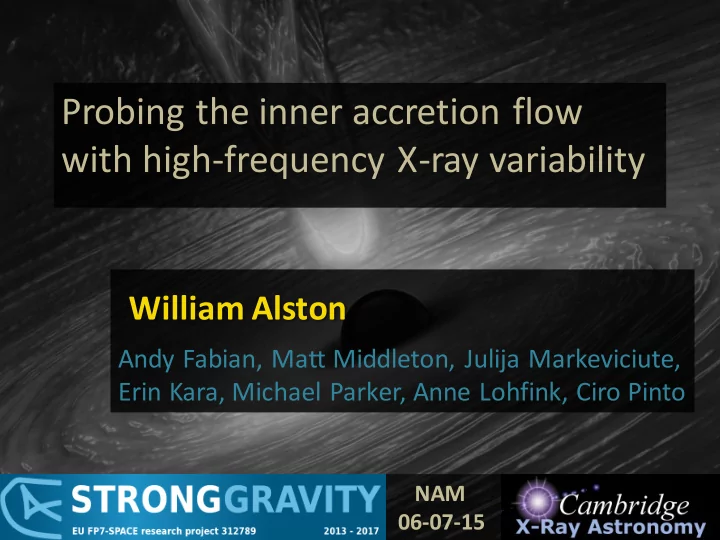

Probing the inner accretion flow with high-frequency X-ray variability William Alston Andy Fabian, Matt Middleton, Julija Markeviciute, Erin Kara, Michael Parker, Anne Lohfink, Ciro Pinto NAM 06-07-15
Iron K α (6.4 keV) and blurring of reflection spectrum can be used to constrain BH spin (see e.g. Reynolds & Fabian 2000)
Iron K α (6.4 keV) and blurring of reflection spectrum can be used to constrain BH spin (see e.g. Reynolds & Fabian 2000) But, AGN spectra are messy, particularly below 1 keV => Want to use spectral variability to understand variable emission components
Variable in all wavebands and on all timescales. Largest, most-rapid variations seen in X-rays Variability amplitude as a function of temporal AGN X-ray Binary frequency
Propagation of mass accretion rate fluctuations Modulation of independent frequencies (e.g. Arevalo & Uttley 2006)
Propagation of mass accretion rate fluctuations S H Corona
Propagation of mass accretion rate fluctuations H Hard band lags S rms-flux relation
Hard AGN lags: Soft
Hard AGN lags: Hard bands lag at low-f Soft bands lag at high-f - Interpreted as reverberation of primary continuum Soft
QPOs in BH-XRBs LFQPOs < 10 Hz HFQPOs > 30 Hz SIMS: A + B HIMS: C LHS: C VH/I states HSS: C Motta + 2011 Remillard & McClintock 2006 See also Belloni & Stella 2014
QPOs in BH-XRBs LFQPOs HFQPOs SIMS: A + B If accretion process is scale invariant then we HIMS: C LHS: C expect to see both HF and LF QPOs in AGN VH/I states HSS: C Motta + 2011 Remillard & McClintock 2006 See also Belloni & Stella 2014
QPO in RE J1034+396 (NLS1) Ob 1: 90 ks 0 1 2 3 4 • 2.6 x 10 -4 Hz (1 hour) • L Bol / L Edd ~ 1-4 • HFQPO (but LFQPO not ruled out) • Only seen in full (0.3-10 keV) in Obs 1 Gerlinski + 2008 Middleton + 2011 See also Vaughan 2010
XMM observations (0.3-0.8 and 1-4 keV) 2007 2,5 1,3,4,6,7 2011
QPO present in 1-4 keV band in the 5 low flux/ spectrally-harder observations ~6 % rms WA, Markeviciute, Kara, Fabian, Middleton, 2014, MNRAS , 445, 16
RE J1034+396 hard band PSD Accretion timescales: XRBs: ~ 1000 ct/s (M bh ~ 10) AGN: ~ 10 ct/s (M bh ~10 6 ) But, characteristic timescale of variability scales with M bh (10 5 ) Therefore, factor ~1000 more counts per characteristic Now 250 ks of QPO data timescale in AGN
RE J1034+396 time lags Soft lag at QPO (see also Zoghbi + 2011 ) Evidence for Fe K reverberation from QPO Markeviciute, WA, et al, in prep Uttley et al 2014
Phase resolving the QPO Following Tomsick & Kaaret (2001): • Filter light curve with filter width +/- 20% QPO freq. • Find minima and slice into X equally space phase bins between minima. Sum over phase bins. Markeviciute, WA, Kara, Fabian & Middleton, in prep
Phase resolved spectroscopy Markeviciute, WA, Kara, Fabian & Middleton in prep
A QPO in MS 2254.9-3712 (NLS1) 1.5 x 10 -4 Hz QPO detected in hard band Alston + 2015, MNRAS, 449, 467
Cross-Spectral products between soft (0.3-0.7) and hard (1.2-5.0) bands Soft lags observed in some BHB HFQPOs Mendez + 2013
Time delays as a function of energy at a given frequency Positive lag indicates lag of comparison band vs total energy band (minus comparison band) Alston + 2015, MNRAS, 449, 467
Mean and rms -spectra Mean spectrum well described by two absorbed PL ( Γ ~2.8; 1.5) plus neutral reflection Hard QPO spectral variability observed in BHBs and RE J1034 (e.g. Belloni 2010 review) Alston + 2015, MNRAS, 449, 467
Principle components analysis (PCA) NGC 4051 Variability is broken down into set of variable spectral components. Alston + 2015, MNRAS, 449, 467 Parker + 2014
MS 22549 QPO identification • M BH ~ 0.4-1 x 10 7 M sun • Broadband noise present • High coherence in BB noise • 3:2 harmonic (maybe) • ~5 % rms • Consistent with HFQPOs observed in BHBs • LFQPO: M BH < 1 x 10 6 M sun XMM-Newton campaign underway to confirm the QPO
Summary Fast variability probes the inner accretion flow QPOs important probe of the inner accretion flow More counts/timescale in AGN 1 hr QPO detected in 5 low-flux/spectrally harder observations of RE J1034+396 2 hr QPO detected in MS 2254.9-3712 Shows similar spectral-timing properties to RE J1034 Consistent with being HFQPO Reverberation lag seen at f QPO Constraint for QPO models Evidence for two independent variability processes Reverberation from faster variability component
Cross Spectrum 𝒚 𝒖 ,𝒛 𝒖 𝒀 𝒈 ,𝒁(𝒈) 𝑫 𝒚𝒛 = 𝒀 ∗ 𝒈 𝒁 𝒈 = 𝒀 𝒁 𝒇 𝒋(𝝔 𝒛 −𝝔 𝒚 ) 𝟑 𝑫 𝒚𝒛 (𝒈) 𝜹 𝟑 (𝒈) = 𝒁(𝒈) 𝟑 𝒀(𝒈) 𝟑 𝝔 𝒈 = 𝐛𝐬𝐡 𝑫 𝒚𝒛 𝒈 𝝊 𝒈 = 𝝔 𝒈 𝟑𝝆𝒈 e.g. Vaughan & Nowak (1997)
PG 1116+215: another QPO detection? (2.6 σ ) PCA 1 PCA 2 PCA 3 Parker et al 2015
What about other Seyferts? Ark 564 (NLS1) PSD modelled with two broad Lorentzians Hard lags seen at low f, with switch to soft lag at high frequency Lorentzian 𝜏/2𝜌 𝑀𝑝𝑠 𝜉 = 𝑂 [ 𝜉 − 𝜉 0 2 + (𝜏/2) 2 ] McHardy et al (2007)
PSD modelled with PL + Lor See soft lag at frequency where Lor peaks Sample of 8 objects
Soft lag vs Lorentzian Central frequency Lag width vs FWHM
Variability power vs λ Edd Ratio of integrated power in Lorentzian relative to that in PL noise λ Edd = L Bol / L Edd Variability power in Lorentzian increases with λ Edd
Phase resolved spectroscopy Modulation of heating rate with no modulation of cooling rate Markeviciute, WA, in prep Zycki & Sobolewska 2005
Recommend
More recommend